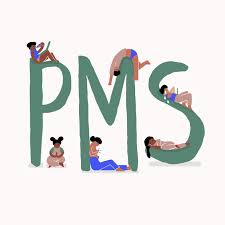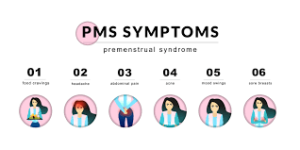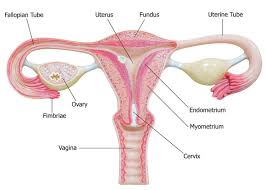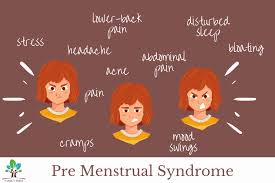Premenstrual Syndrome (PMS):

PMS typically stands for “Premenstrual Syndrome.” It refers to a combination of physical, emotional, and psychological symptoms that many people experience before the onset of menstruation.
These symptoms can vary widely among individuals but may include mood swings, irritability, bloating, fatigue, headaches, breast tenderness, and food cravings, among others.
PMS usually occurs in the days leading up to menstruation and often resolves once menstruation begins.
However, for some individuals, these symptoms can be severe and may interfere with daily activities, in which case it might be referred to as premenstrual dysphoric disorder (PMDD), a more severe form of PMS.
Premenstrual Syndrome- Symptoms:

1. Physical Symptoms:
Bloating:
Many individuals experience bloating, which is a feeling of fullness or swelling in the abdomen due to water retention.
Breast Tenderness: Swelling, soreness, or tenderness in the breasts is a common symptom of PMS.
Headaches: Some people experience headaches or migraines in the days leading up to menstruation.
Muscle or Joint Pain: Pain or discomfort in the muscles and joints, such as back pain or abdominal cramping, may occur.
Acne: Skin breakouts or worsening of acne can occur due to hormonal changes.
2. Emotional Symptoms:
Mood Swings: Fluctuations in mood, such as feeling happy one moment and then suddenly sad or irritable, are common.
Irritability: Heightened sensitivity and irritability are common emotional symptoms of PMS.
Anxiety: Some individuals may experience increased feelings of anxiety or nervousness.
Depression: Feeling down, sad, or hopeless is another emotional symptom that can occur before menstruation.
Tension or Anger: Increased feelings of tension, frustration, or anger may arise.
3. Behavioral Symptoms:
Changes in Appetite: Appetite may fluctuate, with some individuals experiencing increased hunger or food cravings, especially for sweets or salty foods.
Food Cravings: Cravings for specific types of food, such as chocolate, carbohydrates, or salty snacks, are common.
Sleep Disturbances: Insomnia (difficulty falling or staying asleep) or excessive sleepiness may occur.
Difficulty Concentrating: Some individuals may have difficulty concentrating, focusing, or remembering things during PMS.
4. Other Symptoms:
Fatigue: Feeling tired, lethargic, or lacking in energy is a common symptom of PMS.
Digestive Issues: Some individuals may experience gastrointestinal symptoms such as constipation, diarrhea, or nausea.
Changes in Libido: Sex drive may fluctuate, with some individuals experiencing a decrease in libido.
These symptoms typically occur in the days leading up to menstruation and may vary in severity from person to person and from cycle to cycle.
While PMS symptoms are usually mild to moderate and resolve once menstruation begins, for some individuals, they can be severe and significantly impact daily functioning.
If PMS symptoms are severe or interfere with daily life, it’s important to consult a healthcare provider for further evaluation and management.
Premenstrual Syndrome- Timing:

Symptoms typically start to manifest during the luteal phase of the menstrual cycle, which begins after ovulation and ends with the start of menstruation.
Symptoms usually peak a few days before menstruation begins and then improve or disappear once menstruation starts.
Premenstrual Syndrome- Causes:

The exact causes of PMS are not fully understood, but several factors are believed to contribute to the development of PMS symptoms. Here are some detailed explanations of potential causes:
1. Hormonal Fluctuations:
Estrogen and Progesterone: Changes in the levels of estrogen and progesterone, two key hormones involved in the menstrual cycle, are thought to play a significant role in PMS.
Fluctuations in these hormone levels during the menstrual cycle may contribute to the onset of symptoms.
2. Neurotransmitter Imbalances:
Serotonin: Changes in serotonin levels, a neurotransmitter that affects mood regulation, may contribute to mood-related symptoms of PMS such as irritability, depression, and anxiety. Fluctuations in estrogen and progesterone levels can influence serotonin activity.
3. Sensitivity to Hormonal Changes:
– Some individuals may be more sensitive to hormonal changes during the menstrual cycle, making them more susceptible to experiencing PMS symptoms.
4. Chemical Changes in the Brain:
Gamma-Aminobutyric Acid (GABA): GABA is another neurotransmitter that plays a role in regulating mood and anxiety. Changes in GABA levels during the menstrual cycle may contribute to mood swings and anxiety symptoms associated with PMS.
5. Psychological and Environmental Factors:
Stress: High levels of stress can exacerbate PMS symptoms. Stress management techniques such as relaxation exercises, mindfulness, and stress reduction strategies may help alleviate symptoms.
Poor Diet: Dietary factors such as consumption of high-sugar foods, caffeine, alcohol, and insufficient intake of nutrients like calcium and magnesium may worsen PMS symptoms.
Lifestyle Factors: Lack of exercise, poor sleep quality, and smoking are associated with increased severity of PMS symptoms.
6. Genetics:
– There may be a genetic predisposition to experiencing PMS symptoms. Individuals with a family history of PMS or mood disorders may be more likely to experience severe PMS symptoms themselves.
7. Other Medical Conditions:
Underlying Health Conditions: Certain medical conditions such as thyroid disorders, depression, anxiety disorders, and chronic pain conditions may exacerbate PMS symptoms.
Premenstrual Dysphoric Disorder (PMDD): PMDD is a severe form of PMS characterized by debilitating emotional and physical symptoms.
While the exact cause is not fully understood, it is believed to involve a complex interplay of hormonal, genetic, and environmental factors.
Understanding the underlying causes of PMS can help in developing effective treatment strategies, which may include lifestyle modifications, dietary changes, stress management techniques, and, in some cases, medication or therapy.
It’s essential for individuals experiencing significant PMS symptoms to consult with a healthcare provider for proper evaluation and management.
Premenstrual Syndrome- Diagnosis:

There is no specific test for PMS. Diagnosis is usually based on a thorough medical history, tracking of symptoms over several menstrual cycles, and ruling out other potential causes of symptoms.
Premenstrual Syndrome- Treatment:

Treatment for PMS (Premenstrual Syndrome) aims to alleviate symptoms and improve overall quality of life. Here’s a detailed overview of treatment options:
1. Lifestyle Modifications:
Healthy Diet: Consuming a balanced diet rich in fruits, vegetables, whole grains, and lean proteins can help regulate blood sugar levels and minimize PMS symptoms. Limiting caffeine, alcohol, and high-sodium foods may also be beneficial.
Regular Exercise: Engaging in regular physical activity, such as brisk walking, jogging, swimming, or yoga, can help reduce stress, improve mood, and alleviate PMS symptoms.
Stress Management: Practicing relaxation techniques such as deep breathing exercises, meditation, mindfulness, or progressive muscle relaxation can help reduce stress levels and manage PMS symptoms.
2. Medications:
Pain Relievers: Over-the-counter pain relievers such as ibuprofen (Advil, Motrin) or naproxen (Aleve) can help alleviate physical symptoms such as headaches, muscle aches, and menstrual cramps.
Hormonal Birth Control: Oral contraceptives containing estrogen and progestin can help regulate hormone levels and reduce PMS symptoms in some individuals. Continuous or extended-cycle birth control pills may be prescribed to minimize or eliminate menstrual periods, thereby reducing PMS symptoms.
Selective Serotonin Reuptake Inhibitors (SSRIs): Antidepressant medications such as fluoxetine (Prozac), sertraline (Zoloft), or paroxetine (Paxil) may be prescribed to help alleviate severe emotional symptoms of PMS, particularly in cases of PMDD (Premenstrual Dysphoric Disorder).
3. Nutritional Supplements:
Calcium: Some studies suggest that calcium supplementation may help reduce symptoms of PMS, particularly mood-related symptoms such as irritability and anxiety.
Magnesium: Magnesium supplements may help alleviate symptoms such as bloating, breast tenderness, and mood swings associated with PMS.
Vitamin B6: Vitamin B6 supplementation has been shown to reduce symptoms of PMS, particularly depression, irritability, and breast tenderness.
4. Alternative Therapies:
Acupuncture: Acupuncture may help alleviate PMS symptoms by promoting relaxation, reducing stress, and balancing the body’s energy flow.
Herbal Remedies: Some herbal supplements, such as chasteberry (Vitex agnus-castus), evening primrose oil, or black cohosh, are believed to help regulate hormonal balance and alleviate PMS symptoms. However, evidence supporting their effectiveness is limited, and they should be used with caution.
Cognitive-Behavioral Therapy (CBT): CBT techniques can help individuals identify and challenge negative thought patterns, manage stress, and develop coping strategies to deal with PMS symptoms, particularly in cases of PMDD.
5. Medical Evaluation and Monitoring:
It’s important for individuals experiencing severe or debilitating PMS symptoms to undergo a thorough medical evaluation to rule out other underlying medical conditions.
– Regular monitoring of symptoms and treatment effectiveness can help healthcare providers adjust treatment plans as needed to optimize symptom relief and improve overall well-being.
Treatment for PMS is highly individualized, and what works for one person may not work for another. It’s essential for individuals experiencing significant PMS symptoms to work closely with a healthcare provider to develop a comprehensive treatment plan tailored to their specific needs and preferences.
Premenstrual Dysphoric Disorder (PMDD):
Definition: PMDD is a severe form of PMS characterized by more intense emotional and physical symptoms that significantly interfere with daily functioning.
Symptoms: PMDD symptoms are similar to those of PMS but are more severe and may include extreme mood swings, severe depression, panic attacks, and suicidal thoughts.
Treatment: Treatment for PMDD may involve a combination of medications (such as antidepressants) and therapy to help manage symptoms.

It’s important to note that while PMS is common, it’s not something that everyone experiences, and the severity of symptoms can vary greatly among individuals. If symptoms significantly interfere with daily life, it’s advisable to consult a healthcare provider for further evaluation and management.
For more visit here- https://womaniyas.com/2024/02/28/what-is-abortion/
